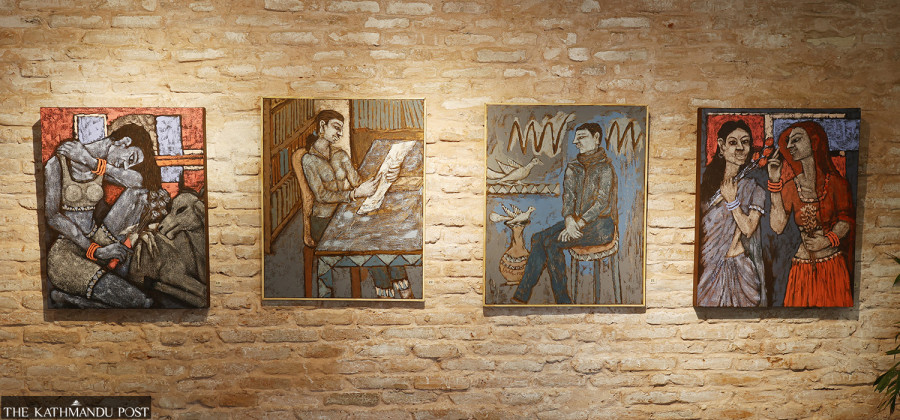
When I saw the exhibition ‘Allegories of Mithila Art Culture & Lifestyle’ by artist Umesh Shah, I was fully expecting traditional Mithila paintings. But I was pleasantly surprised. The paintings and prints weren’t traditional at all; in fact, they were a modern take on the iconic art form. Mithila art, that I was familiar with, usually featured natural elements or scenes from Ramayan or Mahabharat. But Shah’s works don’t fully resemble the Mithila style. At first glance, they appeared peculiar, but as I delved deeper, only then did the analogy of the mythical and terrestrial allegory of ancient and modern Mithila culture begin to emerge. Shah’s works emulate the simplicity of the modest lifestyle of his hometown in Sarlahi.
The exhibition was inaugurated on March 15 at the Bikalpa Art Centre in Pulchowk, Lalitpur. Saroj Mahato is the curator of the exhibition. The collection of artworks is more than just cultural expression. Shah has given the paintings and prints a personal touch by alluding to various personal and societal issues, such as loss, hope, refusal, and empowerment.
Originally, Shah hadn’t even dreamt of becoming an artist. He actually enrolled at Delhi University to study Hindi literature. But there was a part of him that never gave up on art. His friends encouraged him to exhibit some of his works during a college festival. “I remember a professor telling me to pursue fine arts instead of Hindi literature. That advice changed my life and brought me to Kathmandu University at 27,” Shah says. Before graduating, he began experimenting with Mithila art as a framework while searching for his visual style.
Returning to the exhibition, most works were oil paintings or acrylic. Some etchings (or prints) were also present. The paintings' subjects were mainly female—their facial features and anatomical structures were very prominent. The motifs of Mithila art were reflected in the paintings through pots, chairs and animals composed in a two-dimensional perspective. Similarly, Shah revealed that he had also taken inspiration from ancient Egyptian art, which is visible in the subjects’ geometric style. He was significantly influenced by his professor, who taught him the intricacies of ancient Egyptian art during the beginning days of his art school. “In college, we were taught Egyptian art for almost four weeks, and I thoroughly enjoyed it,” he says. “I tried incorporating the beauty of these tribal art styles into my works.”
The Mithila art form is primarily practised in the Tarai regions and the bordering states of India. However, in recent years, its popularity has grown significantly in Kathmandu and worldwide. Traditionally, village women are the ones that make Mithila art—not on canvas but in their homes—everyday images, stylised figures and motifs with natural pigments and dyes: green colour derived from leaves, yellow from turmeric and other colours from different flowers. Shah recalls his childhood when he would observe his grandmother making traditional Mithila art on the walls during various family functions and festivities. This ignited his interest towards art, and he started copying illustrations from textbooks.
While drawing inspiration for his artwork, Shah was influenced by his upbringing, where he would indulge in outdoor activities. He recalls himself as a quiet adolescent and a lover of nature who did not have many friends. “I would spend hours on a tree branch or near the river just observing people and their day-to-day activities,” Shah says. This humanistic approach is clearly reflected in his paintings depicting unique aspects of the region he grew up in—from everyday scenes to ceremonial rituals. This reflection of where he spent his childhood eventually became his signature style.
In his curatorial note, Saroj Mahato calls Shah’s work a masterful relic, a mindful personification and representation of the beauty of the Mithila and Egyptian art styles. Mahato recognises that Shah draws his figures flat, using multiple perspectives and side views to make the forms more recognisable and appreciable in the same way as they are seen incorporated into daily life. Mahato reveals that “The bold features in Shah's paintings lend them a dark and somewhat sombre tone, characterising his painting series as a “dark period”—both symbolically and personally, as well as artistically.”
When you look at the paintings, you will notice that a lot of work has been put into the artworks’ motifs. The sombreness of the painting and the masculine features of the female subjects all seem to be telling a story—albeit a gloomy one. The paintings try to emulate Picasso’s blue period with their melancholic aura. Unlike the traditional Mithila paintings that are free-flowing, colourful and inspired by ancestral art, Shah’s collection is more sullen but just as (if not more) introspective.









